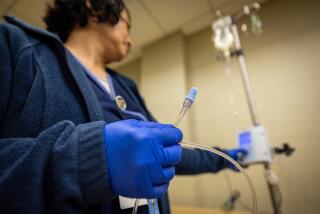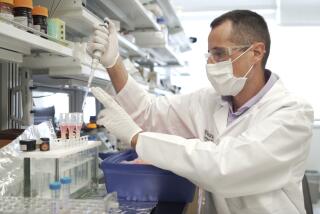Experimental drug reduces protein clumps and slows memory loss in early Alzheimer’s
- Share via
In the search for a treatment capable of changing the course of Alzheimer’s disease, new findings are offering a rare glimmer of hope: In a preliminary trial of subjects suffering from memory and thinking problems or diagnosed with early Alzheimer’s, a bioengineered medication called aducanumab has demonstrated the ability to clear accumulations of beta-amyloid proteins — a hallmark of Alzheimer’s — from the brain.
And compared with subjects receiving a placebo medication, those who got monthly infusions of aducanumab in high doses appeared to experience less progressive loss in mental function.
The results of the early clinical trial, reported Wednesday in the journal Nature, offer new evidence that clearing amyloid plaques might be an effective strategy for preventing, halting or even reversing Alzheimer’s dementia, especially if the degenerative brain disorder is detected and treated early.
“It is a hopeful sign,” said Dr. James A. Hendrix, director of global science initiatives for the Alzheimer’s Assn. “This is a small trial, but it still is exciting for a number of reasons.
“I am cautiously optimistic,” he said.
The new study reflects the findings of a trial designed primarily to test the safety of aducanumab at a range of doses. The drug’s developer, Washington, D.C.-based Biogen Inc., is soon to launch a pair of much larger trials designed to test aducanumab’s effectiveness as a treatment for Alzheimer’s.
“We hope to see these findings confirmed,” Hendrix said.
Although aducanumab holds promise as a potential Alzheimer’s drug, it is for now an early answer to a more basic question about Alzheimer’s disease: What role do clumps of beta-amyloid protein play in the disease?
As long as 25 years ago, scientists suspected a role for amyloid plaques — accumulations in the brain of beta-amyloid proteins — in Alzheimer’s disease. When they examined the brains of people who died after suffering a progressive loss of memory and reasoning skills, scientists typically found clumps of beta-amyloid surrounded by destroyed synapses and brain cells that had long since died.
But whether those clumps were a cause of Alzheimer’s dementia or just another symptom of the mysterious disease process wasn’t clear.
If a cure to this scourge were to be found, that unanswered question was important: If accumulating amyloid plaques in the brain precipitated a patient’s decline in memory and thinking, developing or discovering drugs that cleared those aggregations — or prevented them in the first place — could be key. But if amyloid plaques were incidental to some other process causing memory loss, then fighting them was probably a distraction.
Over the last decade or so, the “amyloid hypothesis” has been put to the test often, without clear results. Many experimental therapies have sought and failed to prevent or clear amyloid plaques. Where a few therapies have succeeded in doing so, patients beset with dementia symptoms failed to improve, and their loss of memory and function continued unabated.
In the meantime, improvements in brain-imaging methods have at least made it possible to measure amyloid deposits in living brains. In the current study, subjects were all people who had substantial amyloid brain clumps — just one factor that put them at risk for a progressive loss of memory. The other factor was that their memory loss was already evident: All had been diagnosed either with mild Alzheimer’s or with mild cognitive impairment — a more subtle level of confusion and forgetfulness that frequently precedes an Alzheimer’s diagnosis.
In these preliminary findings on aducanumab, treatment not only reduced the accumulation of amyloid plaques; it also appeared to slow the inexorable slide into dementia that most subjects were expected to suffer.
After a year of monthly infusions of aducanumab therapy, the brains of subjects who got the highest dose had significant reductions in their baseline levels of amyloid plaque accumulation. Their scans showed a level of amyloid plaques very near the cutoff point for normal protein accumulation. Those who got a placebo drug showed, on average, no change in amyloid plaque above the levels shown on baseline scans.
And on a key test of mental function, subjects who got the experimental drug showed less progression toward dementia at the one-year mark than did those who got placebo. How much less progression was proportionate to the dose they got.
“The dose-related reduction in brain amyloid with aducanumab is dramatic and convincing,” said Dr. Paul Aisen, director of the Keck School of Medicine’s Alzheimer’s Therapeutic Research Institute at USC. Aisen, who has consulted extensively with Biogen but was not involved in the newly published clinical trial, said that if confirmed by further trials, the benefits of a therapy like aducanumab “would represent a true breakthrough” in the treatment of Alzheimer’s disease.
The clinical trial did raise a safety concern. About 41% of those getting the highest dose and 37% of those getting the second-highest dose developed a complication of brain-fluid accumulation that hampered brain-imaging and was sometimes linked to headaches, visual disturbances and confusion.
The complication tended to disappear four to 12 weeks into treatment. But it prompted 46% of those who developed it to drop out of the clinical trial.
Increasingly, the most promising experimental therapies appear to be those that target people who are at risk for Alzheimer’s, or who have some of the earliest brain changes seen in the disease but who do not yet exhibit any cognitive deficits. In planning clinical trials, that has put a premium on finding subjects who carry gene variants that make Alzheimer’s more likely, or who have a family history of the disease.
But research on treatments for those already affected by dementia continues as well. For people interested in participating in studies and trials, the Alzheimer’s Assn. has developed a program called Trial Match that can connect potential study participants with researchers exploring all aspects of the disease.
Follow me on Twitter @LATMelissaHealy and “like” Los Angeles Times Science & Health on Facebook.
MORE IN SCIENCE
After Ohio passed abortion law, risk of complications tripled
Pediatricians urge states to get tough on parents who don’t want to vaccinate their kids
3.2 million years after her death, autopsy reveals Lucy probably died after falling from a tree







